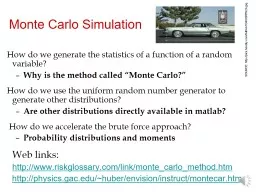

Why is the method called Monte Carlo How do we use the uniform random number generator to generate other distributions Are other distributions directly available in matlab How do we accelerate the brute force approach ID: 920077
Download Presentation The PPT/PDF document "How do we generate the statistics of a f..." is the property of its rightful owner. Permission is granted to download and print the materials on this web site for personal, non-commercial use only, and to display it on your personal computer provided you do not modify the materials and that you retain all copyright notices contained in the materials. By downloading content from our website, you accept the terms of this agreement.
Slide1
How do we generate the statistics of a function of a random variable?Why is the method called “Monte Carlo?” How do we use the uniform random number generator to generate other distributions?Are other distributions directly available in matlab? How do we accelerate the brute force approach?Probability distributions and moments Web links: http://www.riskglossary.com/link/monte_carlo_method.htm http://physics.gac.edu/~huber/envision/instruct/montecar.htm
Monte Carlo Simulation
SOURCE: http://pics.hoobly.com/full/AA7G6VQPPN2A.jpg
Slide2Basic Monte CarloGiven a random variable X and a function h(X): sample X: [x1,x2,…,xn]; Calculate [h(x1),h(x2),…,h(xn)]; use to approximate statistics of h.Example: X is U[0,1]. Use MCS to find mean of X2
rng(9); %set seed so that script will produce repeatable results x=rand(10);y=x.^2; meancol=mean(y)meancol =0.0947 0.4567 0.5221 0.4693 0.3655 0.1874 0.2758 0.2041 0.2619 0.2485meanall=mean(meancol)meanall =0.3086What is the true mean
SOURCE: http://schools.sd68.bc.ca/ed611/akerley/question.jpg
SOURCE:
http://www.sz-wholesale.com/uploadFiles/041022104413s.jpg
Slide3Visualizing distributions x=randn(10000,1); hist(x,20) vs. x=randn(100,1); hist(x,10)
Slide4Cumulative density function (CDF)CDF shows the probability F of X<xCdfplot(x)With 100samples[cdf,xaxis]=ecdf(x); See notes page
Slide5With 10,000 samples it looks betterUsing 10,000 samples we get
Slide6Histogram of averagex=rand(1000);y=mean(x);hist(y)We start with uniform distribution, but averaging moves it towards normal narrowing toward the meanstd(y)=0.0092std(x)=0.2887
Slide7Distribution of x2x=rand(1000);z=reshape(x,[1000000,1]);z2=z.^2; cdfplot(z2)hist(z2,500)As expected the CDF(0.81)=0.9
Slide8Other distributionsOther distributions available in matlabFor example, Weibull distribution
y=wblrnd(100,1.5,1,10000000);>> hist(y,500)
Slide9Correlated VariablesFor normal distribution can use Matlab’s mvnrnd R = MVNRND(MU,SIGMA,N) returns a N-by-D matrix R of random vectors chosen from the multivariate normal distribution with 1-by-D mean vector MU, and D-by-D covariance matrix SIGMA.
Slide10Examplemu = [2 3];sigma = [1 1.5; 1.5 3];r = mvnrnd(mu,sigma,20);plot(r(:,1),r(:,2),'+')What is the correlation coefficient?
Slide11Problems Monte CarloUse Monte Carlo simulation to estimate the mean and standard deviation of x2, when X follows a Weibull distribution with a=b=1.Calculate by Monte Carlo simulation and check by integration the correlation coefficient between x and x2, when x is uniformly distributed in [0,1]
Slide12Latin hypercube samplingX = lhsnorm(mu,SIGMA,n) generates a latin hypercube sample X of size n from the multivariate normal distribution with mean vector mu and covariance matrix SIGMA. X is similar to a random sample from the multivariate normal distribution, but the marginal distribution of each column is adjusted so that its sample marginal distribution is close to its theoretical normal distribution.
Slide13Comparing MCS to LHSmu = [2 2];sigma = [1 0.2; 0.2 3];r = lhsnorm(mu,sigma,20);mean(r)= 2.0389 2.0316cov(r) 1.0173 0.8496 0.8496 3.3286
rng(9); r = mvnrnd(mu,sigma,20);plot(r(:,1),r(:,2),'+')mean(r)=1.8526 2.9458cov(r) 1.1215 1.1709 1.1709 3.5390
Slide14Evaluating probabilities of failureFailure is defined in terms of a limit state function that must satisfy g(r)>0, where r is a vector of random variables.Probability of failure is estimated as the ratio of number of negative g’s, m, to total MC sample size, NThe accuracy of the estimate is poor unless N is much larger than 1/PfFor small Pf
Slide15problems probability of failureDerive formula for the standard deviation of estimate of PfIf x is uniformly distributed in [0,1], use MCS to estimate the probability that x2>0.95 and estimate the accuracy of your estimate from the formula.3. Calculate the exact value of the answer to Problem 2 (that is without MCS).
Source: Smithsonian InstitutionNumber: 2004-57325
Slide16Separable Monte CarloUsually limit state function is written in terms of response vs. capacity g=C(r)-R(r)>0Failure typically corresponds to structures with extremely low capacity or extremely high response but not bothCan take advantage of that in separable MC
Slide17Reading assignmentRavishankar, Bharani, Smarslok B.P., Haftka R.T., Sankar B.V. (2010)“Error Estimation and Error Reduction in Separable Monte Carlo Method ” AIAA Journal ,Vol 48(11), 2225–2230 .
Source: www.library.veryhelpful.co.uk/ Page11.htm